Eating These Leftovers Could Actually Be Dangerous For You
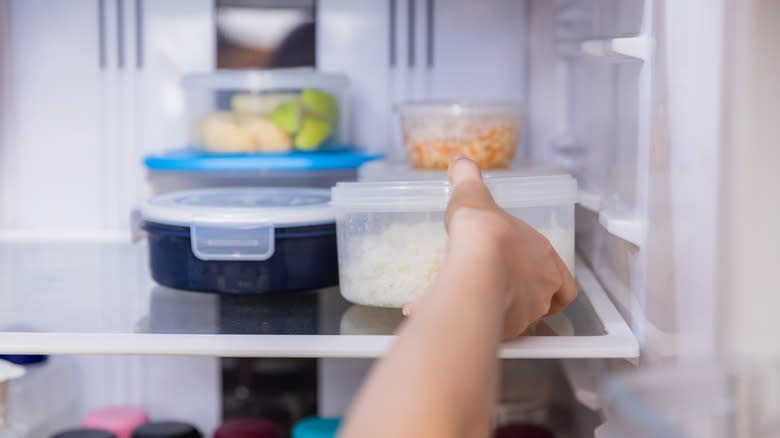
Should you eat those leftovers in your fridge? You've done the sniff test. They look fine. Yet, something still has you on edge. How can you know if they're truly safe?
According to the USDA, most leftovers are safe to consume for three to four days -- and we're eternally grateful for this. Leftovers are the gifts that keep on giving. If you made a delicious dinner, you can enjoy it for days to come, or if you're feeling particularly lazy, you can scrounge up remnants from previous meals. And for those that lead hectic lives, batch cooking can be a healthy alternative to eating out. However, not all food keeps well; some can even be dangerous when consumed as leftovers.
When certain foods are reheated, their chemical composition is altered, causing nasty side effects. Other dishes are prone to growing harmful bacteria at a much faster rate. This could lead to an upset stomach or even full-blown food poisoning. But when it comes to leftovers, common sense goes a long way. Properly stored and reheated foods are usually safe to consume. Regardless, it's good to be aware of potential dangers and take the appropriate precautions. So, which foods are we referring to? Read on to discover which leftovers could be dangerous -- and should be gobbled up all in one go.
Read more: This Was The Most Popular Recipe The Year You Were Born
Fried Food
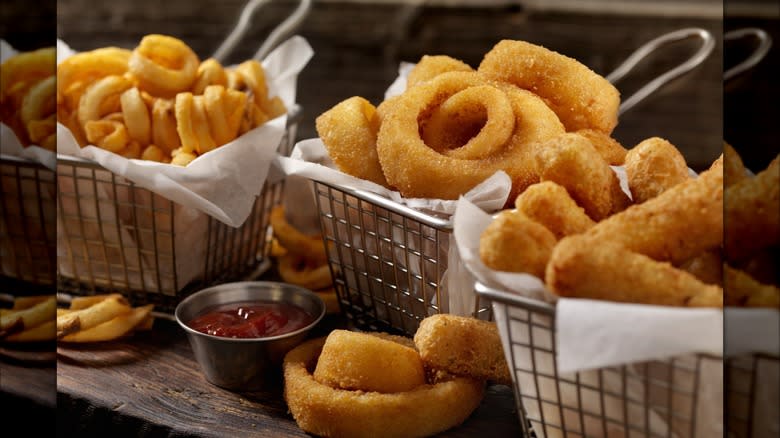
Fried foods can really hit the spot when you crave something salty and fatty. But with these foods, you're better off eating them in one sitting. Fries, breaded chicken, and the like are often fried in cheap cooking oil. Many of these, including soy and canola oil, are not heat stable, meaning their chemical composition changes when they reach a certain threshold. When that happens, they release free radicals, which can wreak havoc on our bodies.
We've all heard about free radicals and antioxidants, but you might not understand precisely how they work. Free radicals have an unpaired electron and roam the human body searching for that electron match. They target human cells, either donating or stealing their electron. When this happens, it alters your cells, causing oxidative stress that can accelerate aging or lead to cancer and inflammatory diseases, per Pharmacognosy Reviews.
As you can see, fried foods cooked in the wrong oils can be harmful enough as is. And reheating them only exacerbates the problem. Whether you're frying your leftovers on the stove or zapping them in the microwave, you're exposing those unstable fats to more heat, creating even more free radicals in the process.
Buffet Foods
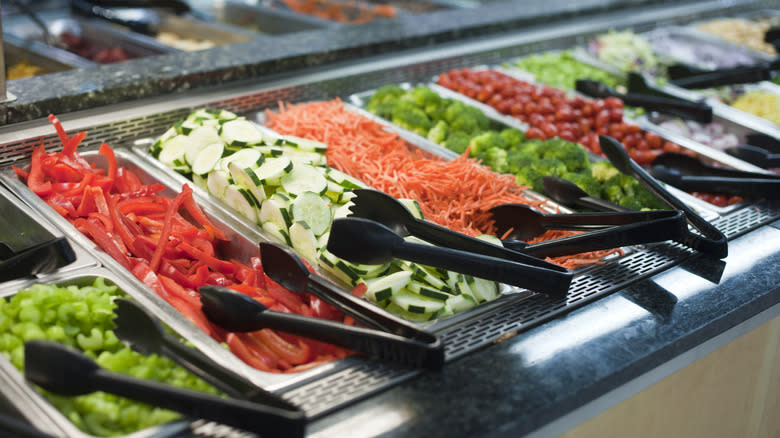
There's a reason some people wince at the thought of eating at a buffet. There are plenty of red flags at buffet restaurants, and multiple hands diving into communal pots is a recipe for disaster. You might wash your hands regularly, but not everyone can say the same. Some may even neglect to sanitize their hands after using the bathroom or cough dangerously close to those salad stands.
Then there's the issue of cross-contamination. A buffet has a wide array of dishes -- which is part of its allure. But as people move from one dish to the next, scooping different foods onto the same plate, the odds of bacteria mingling inevitably increase. If one item grows harmful pathogens, it's much more likely to infect others, especially when hot and cold foods mix.
Buffets are also known to let food sit out for extended periods. According to the CDC, bacteria multiply at dangerous rates when food is in the "Danger Zone" (between 40 and 140 degrees Fahrenheit). It's hard to know the exact temperatures of buffets or how long the food has been there. The CDC recommends tossing any food that's left out for longer than 2 hours -- and if you're at an outdoor buffet on a hot day, that period is cut in half. By the time you get home with your buffet leftovers, they may be well over these recommendations. With all these elements combined, we're not sure buffet food leftovers are worth the risk.
Seafood

Unless you live by the water, it's hard to tell how fresh your seafood is. According to the USDA, raw fish and shellfish should only be kept one to two days before cooking or freezing. By the time it reaches your plate, it might be at its prime or even slightly beyond. And as the USDA also notes, refrigerating it can slow bacterial growth, but can't prevent it altogether.
Overall, seafood is more susceptible to growing harmful bacteria than meat. This has to do with the temperature of cold water fish. The enzymes and bacteria of fish are used to existing in frigid waters, so they're much more likely to survive refrigerator temperatures.
When it comes to fish fillets, we often don't cook them as thoroughly as we would chicken. Take salmon, for example. Salmon is often left a little pink in the middle to enhance flavor and preserve those heart-healthy fats. Leaving it a little raw makes for a delicious meal in the moment, but it also speeds up the rate at which spoils.
Rice

Uncooked white rice doesn't need an expiration date, but cooked rice is another story. The Bacillus cereus bacteria is naturally present in plants and soil. When rice is cooked, the heat is enough to kill off the majority of this harmful bacteria. However, according to the National Health Service, the B. cereus spores can survive high temperatures, and once the rice cools, these spores multiply and produce dangerous toxins. When you take leftover rice out of the fridge, every second it spends cooling gives the spores a chance to grow.
Bacteria are always present in our gut, and a healthy immune system is designed to fight off low levels of toxins. But if these bacteria are present in large amounts, you'll know quite quickly. The Cleveland Clinic reports that symptoms of Bacillus cereus poisoning show up as early as one hour after consuming contaminated rice and can include nausea, vomiting, and diarrhea. Luckily, most people recover within 24 hours with proper rest and hydration.
Sushi

The combination of rice and raw seafood is a double whammy in the danger department. As we mentioned, cooked rice tends to grow toxic spores when left at room temperature. And since sushi is meant to be consumed cold, most people don't reheat it to kill pathogens.
While many leftovers can be safely stored for three to four days, the FDA only recommends keeping raw seafood for one to two days. They also suggest storing it in tightly wrapped plastic or foil. But more often than not, people leave sushi in the takeout box it came in, which might be loosely packaged and exposed to air.
Raw seafood is linked to several foodborne illnesses, including Vibrio. Although Vibrio is more common in raw oysters, the CDC reports that you can also get it from other kinds of seafood like crabmeat and finned fish. As the CDC explains, Vibrio presents a lot like other foodborne illnesses. You can expect the typical watery diarrhea, stomach cramping, and nausea. The symptoms can last anywhere from 1 to 3 days, which is longer than your average bout of food poisoning.
Baked Potatoes

Most people preserve leftovers by putting them in an airtight container in the fridge. This prevents exposure to oxygen and warm temperatures, which is the ideal environment for most bacteria to grow -- "most" being the keyword here. Some bacteria are anaerobic, meaning they don't need oxygen to thrive. Clostridium botulinum is one such bacteria, and baked potatoes are often the perfect breeding ground for it, especially when these potatoes are wrapped in foil, as noted by Food Poisoning News. This bacteria can survive baking and continue to germinate. So, if you're thinking about popping baked potatoes in the fridge, we'd think again.
Clostridium botulinum is the same neurotoxin used to produce botox and can cause paralysis when it comes in contact with human tissue, per Medline Plus. However, botox is a heavily diluted and controlled substance, and when people get injections, this bacteria is confined to the areas targeted. Hence, you're unable to crinkle that forehead or develop frown lines as easily. But when someone consumes Clostridium botulinum in food, the results are far less predictable.
According to the CDC, Clostridium botulinum spores can grow inside the body, producing toxic effects. Botulism symptoms can range from slurred speech and impaired movement to difficulty breathing. Worst case scenario, the toxin can paralyze your respiratory muscles, preventing you from breathing altogether. This all sounds pretty horrific, but luckily, the WHO reports that botulism is a very rare disease.
Pizza

Pizza makes some of the best leftovers. Many may even argue that day-old pizza is better than the freshly baked stuff. And with those large pizza pies, you can look forward to eating pizza for days to come...but should you?
The good news is it can be perfectly safe to eat pizza that's been stored properly. Per USDA standards, that means sealed in an airtight container and refrigerated within 2 hours of being baked. However, more often than not, people leave that box sitting out far too long at room temperature. And if we are to believe slacker movies, some people even leave pizza out all night and dive in for breakfast.
If you're a fan of eating leftover pizza cold, there's no judgment here. In fact, a Slice survey (via Fox News) reported that just over half of Americans polled prefer cold pizza to other breakfast foods. If you've stored your pizza correctly and it's consumed within four days, you're probably fine. However, if that box has been sitting on the counter for days on end -- and you don't heat the pizza -- your risk of foodborne illness increases.
Chicken
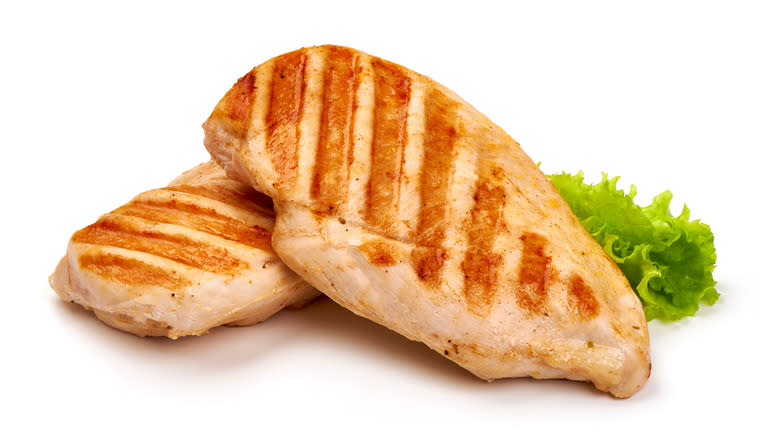
If you're looking for a lean protein source, look no further than chicken. People love cooking with chicken because it's so versatile. It can be used in everything from fresh salads to stir-fries, and if you want to keep things simple, nothing beats a perfectly seasoned chicken breast. But if you've made too much, you might want to be wary of reheating those chicken dishes. A Frontiers in Nutrition study showed that when exposed to repeated bouts of heat, the proteins in chicken break down and become less digestible. This news presents a catch-22 because without reheating, you might not be able to kill those harmful germs.
Raw poultry is known to carry several dangerous pathogens, including Salmonella, E. coli, and Listeria -- and while cooking kills off most of these, the sneaky bacteria that survive can multiply at room temperature, according to the USDA. Your best bet is to reheat the chicken at a high temperature. Unfortunately, if you've ever put a large chicken breast in the microwave, you know this is no easy task. Chicken rarely reheats evenly, and you're often left with a chicken breast that's too hot on the outside but cold in the middle.
Does this mean you should toss your chicken leftovers? Not necessarily. Just practice some safety precautions by storing those leftovers promptly. Only reheat your chicken once, and chop it into bite-sized pieces to ensure thorough heating.
Salad Greens
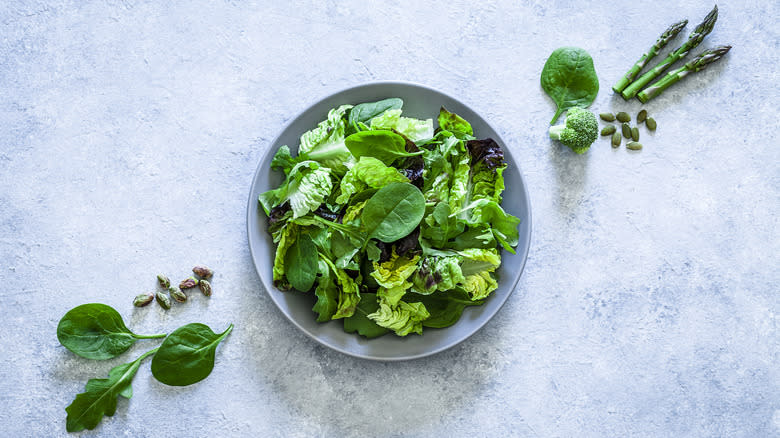
If you are trying to eat healthy, salad greens are a great way to go. Despite a low calorie content, they're rich in nutrients like vitamins A and C and potassium. But if health is your goal, you should also be careful with leftover greens, especially if they're mixed with salad dressing.
Since salad greens are consumed raw, they already have a shorter shelf life. In the 2009 Food Code, the FDA designated cut leafy greens as a TCS food (Time/Temperature Control for Safety). This means they require specific storage regulations because when greens are cut and exposed to air, they provide a hospitable environment for bacterial growth. As such, the FDA gave leafy greens a shelf life of between 12 and 16 days but warned consumers that even if the greens look and taste perfectly normal, they may still contain harmful organisms.
To lower your chances of contracting a foodborne illness, wash your salad greens thoroughly and eat them within this recommended time frame. And although salads are consumed at room temperature, don't leave it out too long. If you're throwing a potluck or barbecue, cover and put that salad away promptly after.
Cooked Spinach

Spinach is a rich source of nitrates. These naturally occurring compounds can support gut health, lower blood pressure, and enhance physical performance, as noted by Healthline. But while nitrates are generally considered healthy, cooking them poses some risks. A Meat Science study showed that when cooked at high temperatures, nitrates can convert to nitrosamines, a known carcinogen. Each time you reheat those spinach leftovers, you risk increasing the nitrosamine content.
Luckily, spinach is a nutrient-dense food high in vitamin C, which can prevent the formation of nitrosamines in the gut, per the International Journal of Vitamin and Nutrition Research. But many of the nutrients in spinach, including vitamin C, are also sensitive to heat, so go easy when heating -- and reheating -- this delicate vegetable. People make many mistakes when cooking spinach, including overcooking it. We recommend sauteeing spinach at a low temperature and eating it in one go.
Eggs

Eggs, even those with clean outer shells, are known to contain Salmonella, a common bacteria that can cause food poisoning. In fact, the CDC says there are an estimated 1.35 million Salmonella infections in the States every year. Food is the leading cause of these infections, and this includes undercooked eggs. Symptoms of Salmonella can appear anywhere from six hours to six days later, according to the Mayo Clinic. You might get stomach cramps and diarrhea, and your digestion may take months to return to normal, depending on the severity of the infection.
If you cook your eggs thoroughly and eat them right away, chances are you're completely safe. But if you like your eggs runny, we wouldn't save them for later. And when boiling eggs to eat on the go, hard-boiled is a safer choice than soft-boiled. Salmonella has a higher chance of surviving in undercooked yolks and runny whites.
We also would be extra careful when reheating boiled eggs in a microwave. Imagine an egg yolk boiling inside its own shell. When these heat bubbles have nowhere to go, they can spontaneously burst, causing an explosion. If this happens when the microwave door is shut, you'll have a nasty cleanup on your hands. But if it happens just as you're opening your microwave, look out!
Previously Reheated Food
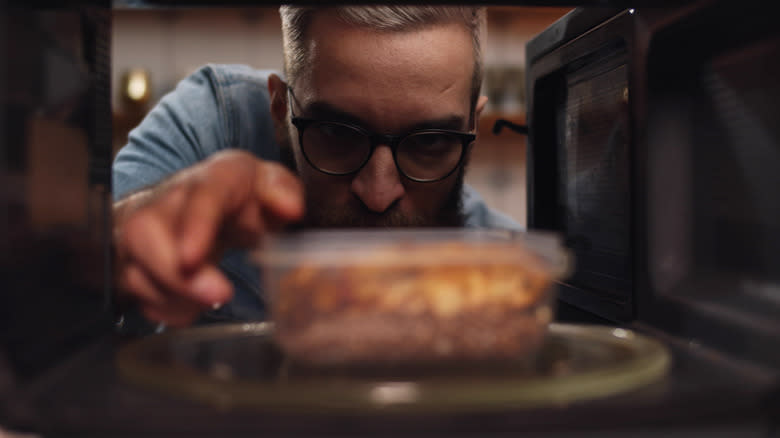
Reheating dishes multiple times increases your likelihood of foodborne illnesses. It's a bit of a numbers game. When you take those leftovers in and out of the fridge, they are bound to sit out at room temperature longer than they should. The USDA recommends only leaving food out for two hours before safely storing it in the fridge or freezer -- and this time frame decreases in hotter climates.
Does this mean an end to batch cooking? Absolutely not. If you've made a giant meal to last you through the week, you just need to take some extra precautions. When reheating your dish, only scoop up what you'll eat at that time. Underestimate rather than overestimate...you can always go back for more, after all. When reheating, the USDA also recommends that your meal reaches 165 degrees F and is heated evenly throughout. This might mean stirring your food a few times as it warms up. Doing this will not only lower your chances of catching a nasty infection, but it will also make your meal more enjoyable.
Read the original article on Daily Meal.

